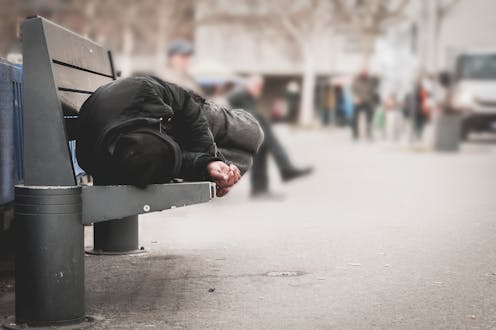Ex-prisoners are more likely to become homeless but the reverse isn't true
- Written by Guy Johnson, Professor, Urban Housing and Homelessness, RMIT University

On the night the 2016 census was taken, more than 116,000 Australians were homeless. This was a 30% increase from the decade before.
What has driven this increase is difficult to pin down, but research points to a lack of affordable housing, poverty and personal vulnerabilities such as trauma, mental illness and substance misuse as key factors.
Read more: Ghost-hunting: will the census reveal the true scale of homelessness in Australia?
We recently published a paper in the Journal of Quantitative Criminology, exploiting a rich dataset derived from tracking 1,600 disadvantaged respondents over approximately three years.
And we found people who have been incarcerated are at a greater risk of becoming homeless. But interestingly, the reverse isn’t true – homeless people are not at greater risk of incarceration.
Identifying similarities
Like the homeless population, Australia’s prison population has increased by 56% in the past decade, from 25,968 to 40,577 people.
Social researchers and policymakers have long been aware of a strong association between incarceration and homelessness. Local and international studies consistently report the homeless are over-represented in prison and ex-prisoners are over-represented among the homeless.
Read more: Youth homelessness efforts get a lowly 2 stars from national report card
That such a strong association exists should come as no surprise.
Both populations share many similar characteristics – lower education levels, high rates of mental and physical illness and substance misuse, as well as high rates of economic disadvantage.
Yet, despite numerous studies, the question of whether this association reflects causal relationships has proven surprisingly difficult to answer.
One reason for this is that researchers have had to rely on samples of either prisoners or the homeless, and these samples are not suited to addressing questions of causality.
Are homeless people more likely to be imprisoned?
Our paper used data from Journeys Home, a study uniquely suited to shedding light on the relationship between incarceration and homelessness. Launched in 2011, Journeys Home not only tracks people exposed to homelessness and housing insecurity over time, but also it captures important information on their housing circumstances and contact with the justice system.
There is no universally agreed definition of homelessness, so we tested two different approaches – broad and literal.
Read more: What’s in the name 'homeless'? How people see themselves and the labels we apply matter
Our broad definition included people sleeping rough, people in emergency accommodation, in boarding houses, couch surfing and people staying temporarily in a hotel or caravan park. This aligns with the way homelessness is commonly defined in Australia.
We found that homelessness, broadly defined, does not increase the risk of incarceration.
Being “literally” homeless is a more limited definition commonly used in the USA. It restricts the definition to those who were on the streets, in squats or staying in emergency or crisis accommodation.
Based on previous research, we expected this form of homelessness would be linked to a higher risk of incarceration.
To our surprise, it wasn’t. Being literally homeless also has no effect.
Why might this be the case?
When we examined forms of contact with the justice system, we found being homeless does not increase the risk of being apprehended or held overnight by the police or sent to court.
This suggests homelessness does not lead to incarceration because it does not increase any type of contact with the justice system usually preceding incarceration.
Are ex-prisoners more likely to become homeless?
The answer is yes, but the immediate effect is modest.
Our research shows the risk of ex-prisoners becoming homeless increases significantly six months after release, and this increased risk persists for nearly another year.
Responding to the delayed and persistent effect of incarceration is important.
Policy interventions such as Reconnect, a transition and post-release support program, provide assistance for a short period (up to 12 weeks) following discharge. While this is clearly warranted, our results suggest the need to broaden and extend existing interventions.
Many ex-prisoners rely on family and friends in the immediate period following release. Many appear to enjoy a “honeymoon” period of six months or so.
At that point, ex-prisoners’ housing starts to breakdown. Many start to couch surf or live in boarding houses, where there is limited housing security and they are exposed to poor living conditions.
Read more: Homelessness: Australia's shameful story of policy complacency and failure continues
Clearly, families provide important social support to ex-prisoners, but they often have limited resources. Based on our research, we feel that policy initiatives should consider ways of engaging and supporting ex-prisoners’ families, as well as funding extended settlement support programs delivered through a range of supported housing arrangements.
A focus on assisting families and extending settlement support programs is the next step in developing policy approaches. These would more effectively mitigate the extended risk of homelessness and housing instability that our research shows ex-prisoners experience.
Authors: Guy Johnson, Professor, Urban Housing and Homelessness, RMIT University





